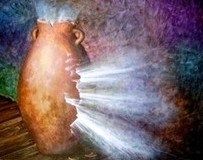
Shownotes
Welcome to Day 1491 of our Wisdom-Trek, and thank you for joining me.
I am Guthrie Chamberlain, Your Guide to Wisdom
Imager - A God-Breathed United Council – Worldview Wednesday
Wisdom - the final frontier to true knowledge. Welcome to Wisdom-Trek! Where our mission is to create a legacy of wisdom, to seek out discernment and insights, to boldly grow where few have chosen to grow before. Hello, my friend, I am Guthrie Chamberlain, your captain on our journey to increase Wisdom and Create a Living Legacy. Thank you for joining us today as we explore wisdom on our 2nd millennium of podcasts. Today is Day 1491 of our Trek, and it is Worldview Wednesday. Creating a Biblical Worldview is essential to have a proper perspective on today’s current events. To establish a Biblical Worldview, you must have a proper understanding of God and His Word. This week, on our Worldview Wednesday episode, we will continue our study based on a course I recently completed taught by Dr. Michael Heiser. Our study is titled “Sons and Daughters of God: The Believer’s Identity, Calling, and Destiny” Throughout this multi-week course, we will demonstrate that, in the Old Testament, “sons of God” and “holy ones” refers to supernatural beings whose Father is God and who work with God to carry out His will and that this divine family was present before humanity. By fully engaging with biblical texts such as Psalm 82; Psalm 89, and Deuteronomy 32:8–9, our study will show that this divine family functions as a template for God’s human family. God desires of humans, as His imagers, to participate in His council. This study addresses issues such as polytheism, the nature of the (little ‘g’) “gods,” and Yahweh's uniqueness. This study will apply insights to the New Testament texts and show how the metaphor of being in God’s family informs our sense of identity and mission as believers.
Imager – A God-Breathed United Council
· Segment 24: Humans Animated by the Breath of God
Introduction
Last week we left off talking about the one outlier in our list of candidates for what the ‘image of God’ idea might be: the possession of a soul, soul/spirit. People use different terminology; we’re not worried about parsing the terms necessarily here, and you’ll quickly see why.
Animals Like Humans
If we’re going to go with biblical language, the idea of having a “soul” is having a nephesh. In Genesis 2:7—this is when God breathes into the man, into Adam, and he becomes a living soul—the Hebrew there is the nephesh chayyah. That’s biblical language. It turns out, though, that if you go back to Genesis 1:21, we read this: “So God created the great sea monsters and every living creature that moves. [the term there is ‘every nephesh hachayyah’]” So animals and humans are described with the same terminology with respect to the “soulishness” of each of them. What it refers to—the nephesh chayyah in both passages—is a reference to this sort of animate life that we sort of know and experience.
I can look at my dog and know that my dog is an animate life form. It looks at me. Something is going on up there in the head. It moves around; it makes decisions, so on and so forth. It decides to go into that room or this room. That’s what animate life is.
Animals and humans are both described with the same vocabulary in the Hebrew Bible. Animals also have a ruach. So for those who want to say, “Well, the nephesh is different than the ruach; the soul is different than the spirit,” we have a problem there too. Ecclesiastes 3:21 has animals possessing a ruach; it’s the same word for “spirit” used of humans.
Nephesh and Ruach Interchangeable
The problem becomes even more than that. If you studied the terms, you would discover that ‘nephesh’ is often translated “soul” in English Bibles, and “spirit” comes from the Hebrew ‘ruach.’
If you studied both of those Hebrew terms, you would learn very quickly that they are used interchangeably to describe animate life, the source of emotions, the source of volition. In other words, decision-making capacity and just generally one’s internal disposition.
So if you are going with Old Testament terminology, nephesh and ruach are not different things. They are interchangeable terms, and the biblical text points that direction in many, many places. According to the Bible, animals are described in the same way from this analysis, the idea of having a soul/spirit as our arbiter if we’re deciding what God's image means. So we can’t use that as our definition. So this is not the right way to determine the uniqueness of humans being in the ‘image of God.’
Summary
So we seem to have a problem. If we go back to last week, the rest of the list's characteristics are all linked to brain function. Of course, the situation is that not all humans at all stages of life, from conception until death, have the same cognitive functions. If they are used that determine possession of the image of God, it leaves some people out.
So all of these standard definitions of being in the image of God have serious weaknesses. We need to understand a little bit better what the image actually is. That realization will take us right back into the family motif and the participatory coworker idea we need to focus on. We’re looking at the Old Testament family of God, specifically the divine beings. We need to look at what God tasked them to do, how they relate to Him, their purpose, and how that becomes a template for how God thinks about humans and how we should think about ourselves.
· Segment 25: Imaging Is What Unites Us

Introduction
I’ve said a couple of times that the plural language of Genesis 1 is related to this idea of imaging, and imaging, the image of God, is what unites God with humans and the members of His heavenly host. We’re talking about how to understand “imaging.” We know what it doesn’t mean, so what does it mean?
First, I think it would be wise for us to have a sentence, a specific way, to think about this in our heads. As human beings, and they as divine beings or the supernatural family of God, they and we were made like Him, like God, for the specific purpose of working with Him. Keep that in mind, and let’s talk about what imaging means. We can see the relationship between He and us once we grasp what the image idea means.
Image of God Is a Status
The image of God is not a thing put into humans. It’s not an attribute or an ability, especially one connected with brain function or any other organ. It’s not a quality; it’s a status. We’re going to unpack that. The key to understanding this idea is the preposition “in” in the phrase “God created humankind in the image of God” or “in His image.”
Different Meanings of the Preposition “In”
The preposition “in”: you need to think about this because it’s going to be the linchpin upon which everything turns in one direction. In our English language, in the course of our everyday conversation, we use the preposition “in” in a lot of different ways. We don’t even think about it, but we do.
For instance, if I say, “Put the dishes in the sink,” what do I mean? I’m asking you to put the dishes in a specific place; I’m talking about location. If I say, “I broke the vase in pieces,” I’m certainly not talking about location; I’m talking about the result of some action: I broke the vase in pieces. If I say, “I wrote the letter in pencil,” I’m not talking about the location of course; I’m talking about the instrument that I used, how I’m doing something: I wrote the letter in pencil.
Those are three different uses of the word “in,” just a little two-letter word. You think, “Well, that can’t be very complicated,” but look at those three examples; they’re all quite different. Let me add a fourth one. If I say, “I work in medicine,”; “I work in education,”; “I work in the ministry,”; what do I mean? I mean, I work as a doctor or a nurse or a PA, something like that. I work as a teacher; I work as a principal, an administrator. In the ministry, I work as a pastor, a youth pastor, maybe some other kind of work, a missionary, something that has to do with Christian ministry—all of these options.
Genesis 1:26–27 Uses Functional “In”
“I work as” treats the preposition “in” in a phrase like “I work in medicine” as functional. I’m using the preposition “in” to denote a role or a function. That is how we need to understand the image of God. That is what we need to take back to Genesis 1: “Let us create humankind [as] our image”—to be our imager, to be like us. How does this unite God and humans, the divine beings of God’s heavenly family? Well, it means that to be an imager means to be God’s representative.
Created as Representative
To be an imager means to be God’s representative. To be created as God’s image is to be created as His representative. I’ve been using a little bit interspersed here; the term “imager” like it’s a verb, and I’m doing that because I think that’s an excellent way to understand it. The image of God isn’t a thing given to you; it is a status you have to do something and to be something. If you were created as God’s imager, you are, by definition, a part of His family, and you are like Him. He has shared His attributes with you, so that you can work for Him and with Him. Now, what unites all of us?
One Creator
The plural language lets us know that he also created the divine members of God’s family; they also image Him; they’re also His representatives; they are like Him. We will be like Him, and we’re going to be like them because we have the same creator. We’re just tasked in different ways.
It’s essential to understand the language goes back to singular because the point of the plural part, “Let us create humankind as our image, our representative,” is to bring humanity into that relationship that they will be part of the same family. They’re also going to be part of the same enterprise. The enterprise, of course, is doing God’s will, doing what God wants. The heavenly host does that in their realm; we do that in our realm. Their realm is supernatural; our realm is terrestrial. That plural language brings us into the picture on sort of an equal footing. We share the status of family members and coworkers, and then when it switches back to the singular, it’s evident that we all only have one creator. We don’t have many creators; we have one, and it’s His image; it’s His imager, that all of us are.
So there’s a very deliberate reason why we go from plural to singular language there. It’s telegraphing some essential concepts and some points. Fundamentally, for us, it’s about family being brought into that relationship, and it’s about being a coworker with God, being His representative in the earth that He has put us on.[1]
That will finish our study for this week’s Worldview Wednesday. Next week we will continue covering “Human Family As Imagers.” Tomorrow we will enjoy our 3-minute Humor nugget that will provide you with a bit of cheer, which will help you to lighten up and live a rich and satisfying life. So encourage your friends and family to join us and then come along with us tomorrow for another day of ‘Wisdom-Trek, Creating a Legacy.’

If you would like to listen to any of our past 1490 treks or read the Wisdom Journal, they are available at Wisdom-Trek.com. I encourage you to subscribe to Wisdom-Trek on your favorite podcast player so that each day’s trek will be downloaded automatically.
Thank you so much for allowing me to be your guide, mentor, and, most of all, your friend as I serve you in through this Wisdom-Trek podcast and journal.
As we take this Trek together, let us always:
- Live Abundantly (Fully)
- Love Unconditionally
- Listen Intentionally
- Learn Continuously
- Lend to others Generously
- Lead with Integrity
- Leave a Living Legacy Each Day
I am Guthrie Chamberlain….reminding you to ’Keep Moving Forward,’ ‘Enjoy your Journey,’ and ‘Create a Great Day…Everyday’! See you Tomorrow!
[1] Heiser, M. S. (2019). Sons and Daughters of God: The Believer’s Identity, Calling, and Destiny. Bellingham, WA: Lexham Press.